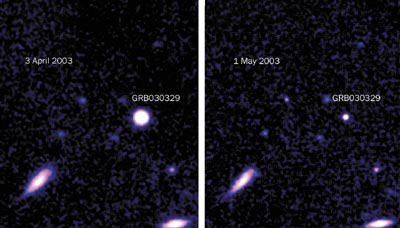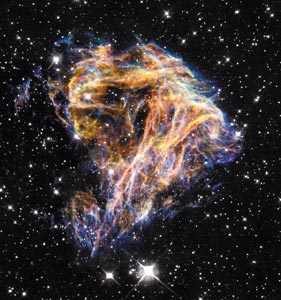
“He who seeks finds.” After decades of speculation on the nature of gamma-ray bursts (GRBs), the very bright event known as GRB030329 is finally unveiling their origin. This burst is a “Rosetta stone” for scientists, revealing for the first time that a GRB and a supernova – the two most energetic explosions known in the universe – occur simultaneously. Thanks to this telling burst, a team of astronomers has pieced together the key elements of the so-called “collapsar” model of long-duration GRBs, from star death to the dramatic birth of a black hole.
NASA’s High-Energy Transient Explorer satellite (HETE-II) initially detected the burst on 29 March 2003 (at 11:37:14 UTC) in the constellation Leo. For more than 30 seconds the burst outshone the entire universe in gamma rays. Its unusual brightness triggered an unprecedented hunt for optical observations around the world. Within 24 hours a first, very detailed, spectrum of the burst’s optical afterglow was obtained by the Very Large Telescope (VLT) of the European Southern Observatory (ESO) at the Paranal Observatory in Chile. The spectrum displays a redshift of 0.1685, corresponding to a distance of 2650 million light-years. This is near for a GRB and explains why this burst is among the 0.2% brightest bursts ever recorded. It provides the long-awaited opportunity to test the many hypotheses and models proposed since the discovery of the first GRBs in the late 1960s.
The afterglow of GRB030329 lingered for weeks in lower energy X-ray and visible light, allowing continued spectral observations with the VLT over a period of one month. The results were published in Nature (J Hjorth et al. 2003) by members of the Gamma-Ray Burst Afterglow Collaboration (GRACE) at ESO. According to the group of 27 researchers from 17 institutes, the spectral changes of the fading source give irrefutable evidence of a direct connection between the GRB and “hypernova” explosion of a very massive, highly evolved star. This is based on the gradual emergence of a supernova-type spectrum, revealing the extremely violent explosion of a star. With velocities well in excess of 30,000 km/sec (10% the velocity of light), the ejected material is moving at record speed, testifying to the enormous power of the explosion.

Hypernovae are rare events and probably caused by the explosion of stars of the “Wolf-Rayet” type. These WR-stars were originally formed with a mass greater than 25 solar masses and consisted mostly of hydrogen. During their WR-phase, having stripped themselves of their outer layers, they consist almost purely of helium, oxygen and heavier elements, produced by intense nuclear burning during the preceding phase of their short life. Such a dense star of about 10 solar masses will rapidly deplete its fuel, triggering a Type Ic supernova/GRB event. The core collapses, without the star’s outer part “knowing”. A black hole forms inside, surrounded by a disc of accreting matter, and within a few seconds launches a jet of matter away from the black hole that ultimately makes the GRB. The jet passes through the outer shell of the star and, in conjunction with vigorous winds of newly forged radioactive nickel-56 blowing off the disc inside, shatters the star. The GRACE team say this “collapsar” model, introduced by Stan Woosley of the University of California in 1993, best explains the observation of GRB030329.
“We’ve been waiting for this for a long, long time,” said lead author Jens Hjorth. “This GRB gave us the missing information. From these detailed spectra we can now confirm that this burst, and probably other long GRBs, are created through the core collapse of massive stars. Most other leading theories are now unlikely.”
As Stan Woosley, one of the co-authors, points out, this does not mean the GRB mystery is completely solved because, “we cannot reach any conclusion yet on what causes short GRBs.” Many astronomers think these bursts, lasting less than two seconds, might be caused by neutron star mergers, but they are still waiting for their “Rosetta stone” burst.
Further reading
J Hjorth et al. 2003 Nature 423 847.





